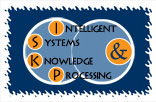

| O-DEVICE is a system developed by Georgios Meditskos and Nick Bassiliades, members of the Intelligent Systems and Knowledge Processing (ISKP) group of the Department of informatics of Aristotle University of Thessaloniki. |
| Home | | Predefined schema | | Rule Abstract Syntax | | O-DEVICE Rules | | Dynamic Rules | | Query Language |
Of course, the answers to a rule depend on the time the query runs. If further OWL instances are added and the query is re-run, a different answer will be obtained. This means that the answer involves only the currently existing instances, i.e. it follows the closed-world assumption. However, the non-monotonic semantics of our rule language (incremental materialization) compensates for future changes in the knowledge base, thus we are able to cope with the open-world semantics of OWL. To demonstrate the use of the deductive rule language, we give as an example the first query defined in the LUBM. This query retrieves all the instances of the class GraduateStudent that have on the property takesCourse the value GraduateCourse0. The definition of this query (namespaces have been removed) using the O-DEVICE deductive rule language is shown below: The above rule is transformed into a CLIPS production rule and is executed by CLIPS. When the execution of the rule is finished, the system tracks the derived objects of the class result and exports them into the defined file export-results.rdf. In the following, we show a sample of the exported results (without namespaces): Here you can find all the LUBM queries in the O-DEVICE query language. |
